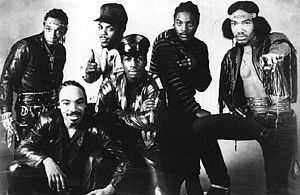Old-school hip hop
Old-school hip hop (also spelled "old skool") describes the earliest commercially recorded hip hop music (approximately 1979–1984),[1] and the music in the period preceding it from which it was directly descended (see Roots of hip hop). Old school hip hop is said to have ended around 1984 due to changes in both rapping technique and the accompanying music and rhythms.

The image, styles and sounds of the old school were exemplified by figures like Afrika Bambaataa, The Sugarhill Gang, Grandmaster Flash, Spoonie Gee, Newcleus, Treacherous Three, Funky Four Plus One, Kurtis Blow, Busy Bee Starski, Lovebug Starski, The Cold Crush Brothers, Kool Moe Dee, Warp 9 and Fab Five Freddy.[2] It is characterized by the simpler rapping techniques of the time and the general focus on party related subject matter.[2]
Musical characteristics and themes
Old-school hip hop is noted for its relatively simple rapping techniques compared to later hip-hop music.[2] Artists such as Melle Mel would use few syllables per bar of music,[3] with simple rhythms [2][3] and a moderate tempo.[4]
Much of the subject matter of old school hip hop centers around partying and having a good time.[2] One notable exception is the song "The Message", which was written by Melle Mel for his hip hop group, Grandmaster Flash and The Furious Five;[2] the song was a hit and introduced social commentary to hip hop. In the book How to Rap, Immortal Technique explains how party content played a big part in old school hip hop: "hip-hop was born in an era of social turmoil... in the same way that slaves used to sing songs on a plantation... that's the party songs that we used to have".[5]
Battle rap was also a part of the old school hip hop aesthetic. Whilst discussing battle rapping, Esoteric said, "a lot of my stuff stems from old school hip-hop, braggadocio ethic".[6] A famous old school hip hop battle occurred in December 1981 when Kool Moe Dee challenged Busy Bee Starski.[7] Busy Bee Starski's defeat by the more complex raps of Kool Moe Dee meant that "no longer was an MC just a crowd-pleasing comedian with a slick tongue; he was a commentator and a storyteller".[7] KRS-One also credits this as creating a shift in rapping in the documentary Beef.[8]
Freestyle rap during hip-hop's old school era was define differently than it is today. Kool Moe Dee refers to this earlier definition in his book, There's a God on the Mic: "There are two types of freestyle. There’s an old-school freestyle that’s basically rhymes that you’ve written that may not have anything to do with any subject or that goes all over the place. Then there’s freestyle where you come off the top of the head".[9] In old school hip hop, Kool Moe Dee says that improvisational rapping was instead called “coming off the top of the head”.[10] He refers to this as “the real old-school freestyle”.[11] This is in contrast to the more recent definition defining freestyle rap as "improvisational rap like a jazz solo".[12]
Old school hip hop would often sample disco and funk tracks such as "Good Times" by Chic. However, the use of funk samples went into a decline from 1983 onwards. A live band was often used, as in the case of The Sugarhill Gang. The use of extended percussion breaks led to the development of mixing and scratching techniques. Scratching was pioneered by Grand Wizard Theodore in 1977, and the technique was further developed by other prominent DJs, such as Grandmaster Flash. One example includes Grandmaster Flash's "Adventures on the Wheels of Steel", which was composed entirely by Flash on the turntables. However, very few tracks contained significant scratching techniques prior to 1981.
References
- ↑ David Toop, Rap Attack, 3rd. ed., London: Serpent's Tail, 2000. (p. 216) ISBN 978-1-85242-627-9
- ↑ 2.0 2.1 2.2 2.3 2.4 2.5 http://www.allmusic.com/explore/style/d2926
- ↑ 3.0 3.1 Edwards, Paul (2009). How to Rap: The Art & Science of the Hip-Hop MC. Chicago Review Press., p. 126.
- ↑ Neumann, Frederich (2000). "Hip hop: Origins, Characteristics and Creative Processes". The World of Music (VWB - Verlag für Wissenschaft und Bildung) 42 (1): 51–63. ISSN 0043-8774.
- ↑ Edwards 2009, p. 19.
- ↑ Edwards 2009, p. 26.
- ↑ 7.0 7.1 "Blow Average".
- ↑ Beef documentary, 2003, Peter Spirer, Aslan Productions.
- ↑ Kool Moe Dee (2003). There's a God on the Mic: The True 50 Greatest MCs. Thunder's Mouth Press., p. 101.
- ↑ Kool Moe Dee 2003, p. 22, 23, 201, 292, 306.
- ↑ Kool Moe Dee 2003, p. 228.
- ↑ Edwards 2009, p. 182.
External links
| ||||||||||||||||||||||||||||||||||||||||||||||||||||||||||||